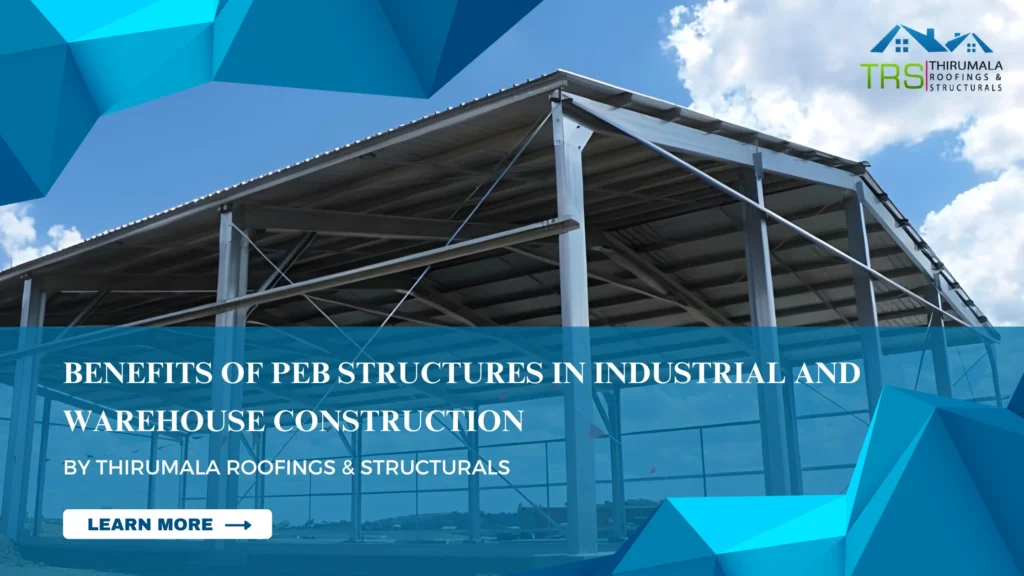Benefits of PEB Structures in Industrial and Warehouse Construction
In the fast-paced world of industrial development and logistics, efficiency, durability, and cost-effectiveness are the driving forces behind modern construction choices. Among the most revolutionary solutions reshaping the industrial sector today are Pre-Engineered Buildings (PEB). These structures have emerged as the ideal solution for factories, warehouses, and logistics centers across India, especially in growing hubs of South India.
At Thirumala Roofings & Structurals, we specialize in designing and delivering advanced PEB structures that cater to the unique needs of industrial and warehousing projects. In this guide, we explore the wide-ranging benefits of using PEB systems for your next big infrastructure project.
What Are PEB Structures?
Steel structures that are manufactured under controlled factory conditions and assembled on-site are known as Pre-Engineered Buildings. Each component, from beams to roofing sheets, is pre-designed for maximum efficiency. Unlike traditional construction that depends heavily on labor-intensive methods and on-site welding, PEBs use bolted connections and standardized parts, saving both time and money.
Common uses for these structures are:
- Industrial plants
- Warehouses
- Storage yards
- Distribution centers
- Workshops
- Cold storage units
1. Faster Project Completion
Pre-Fabrication Saves Time
- PEBs have a significant advantage in that they can be constructed faster. Components are designed, cut, and pre-punched at the manufacturing unit. Once transported to the site, they are assembled using bolt connections.
Parallel Activities
- Unlike traditional construction, where one activity must follow another, PEBs allow for multiple tasks like foundation work and component fabrication to happen simultaneously, reducing the overall project timeline by up to 50%.
2. Cost-Effective Construction
Optimized Material Usage
- PEBs have been designed to use only the necessary amount of steel, preventing unnecessary waste. Since every element is precision-designed, material utilization is maximized, which directly reduces raw material costs.
Reduced Labor & Machinery Cost
- With faster assembly and minimal on-site fabrication, the cost of labor, scaffolding, and heavy machinery is drastically lowered.
Lower Operational Costs
- Thanks to proper insulation, natural ventilation systems, and superior design, PEBs lead to reduced energy consumption in the long run, making them more economical for warehouse or industrial usage.
3. Design Flexibility
Customization for Various Industrial Uses
Whether it’s a cold storage unit requiring temperature control or a logistics warehouse needing wide spans, PEBs can be customized to fulfill a variety of industrial requirements. Clients can define:
- Width & length
- Roofing type
- Load-bearing needs
- Mezzanine floors
- Insulation panels
Aesthetic Appeal
With various finishing options like sandwich panels, color-coated sheets, and canopies, industrial buildings no longer have to look dull or outdated.
4. Superior Strength and Durability
High Load-Bearing Capacity
- PEB structures are designed to handle heavy machinery loads, high rack storage systems, and equipment like gantry cranes — ideal for manufacturing plants and bulk storage.
Corrosion & Weather Resistance
- At Thirumala Roofings & Structurals, we use galvanized steel and anti-rust coatings that protect buildings from corrosion, especially in coastal or high-humidity regions.
Seismic and Wind Load Resistant
- PEBs are structurally analyzed to withstand earthquakes, cyclones, and high wind pressures, ensuring safety for people, materials, and machines.
5. Efficient Space Utilization
Clear Span Design
- Traditional structures require internal support columns, which can interrupt floor space. PEBs, on the other hand, can be constructed with clear spans up to 100 meters, making them perfect for forklift movement, racking systems, and large equipment setups.
Vertical Expansion
- Future expansions, including vertical structures or additional floors, are easier to plan and implement in PEBs due to modular construction techniques.
6. Environmentally Friendly Construction
Minimal Wastage
- Since every piece is custom-made, there’s almost zero on-site material waste. This lowers the project’s environmental footprint.
Energy Efficient
- PEB warehouses and factories can integrate insulation materials like EPS or polyurethane panels to minimize energy consumption, especially important in temperature-controlled units.
Recyclability
- Steel used in PEBs is 100% recyclable. Even after decades of use, the materials can be repurposed, making them a sustainable choice.
7. Low Maintenance Requirements
PEBs need minimal upkeep when compared to concrete or brick buildings. Thanks to the quality of pre-painted roofing sheets, corrosion-resistant coatings, and leak-proof construction methods, periodic maintenance is simple and cost-efficient.
For industrial units where downtime means loss of productivity, low-maintenance structures like PEBs become a major advantage.
8. Safety and Compliance
Fire Safety Options
- PEBs can be equipped with fire-resistant cladding, smoke ventilators, and sprinkler-compatible roofing for added safety.
Factory-Made Precision
- All joints and components are engineered with computer-aided tools to meet national and international safety codes, reducing risks caused by manual errors in traditional construction.
9. Easy Expansion and Modification
PEBs are modular by nature. This makes future expansions extremely easy and cost-effective. Whether it’s extending your warehouse or adding mezzanine floors, you can upgrade your space without significant structural overhauls.
Businesses that anticipate rapid growth or diversification find PEBs to be a smart investment that adapts to changing needs.
Real-World Application: PEBs in Action
Across India and globally, some of the most high-functioning logistics hubs, industrial plants, and storage facilities rely on PEBs. At Thirumala Roofings & Structurals, we’ve executed numerous PEB projects that demonstrate:
- Faster delivery times
- Improved operational efficiency
- Optimized space management
- Long-term structural integrity
Whether it’s a textile unit in Tirupur, a food processing plant in Madurai, or a warehouse in Chennai’s industrial belt, our clients trust us for delivering on-time, on-budget, and on-spec.
➡️ Take a look at the services we offer for pre-engineered buildings at Thirumala Roofings & Structurals.
Conclusion: Build Smarter, Stronger, and Faster with PEBs
In today’s competitive industrial environment, construction methods must be fast, reliable, and cost-effective. Pre-Engineered Buildings offer all this and more — they are not only smarter in design but also stronger and more adaptable than traditional methods.
If you’re planning to build a warehouse, industrial shed, or logistics center, a PEB solution is the way forward.
At Thirumala Roofings & Structurals, we bring years of hands-on expertise in delivering durable, high-performance PEB systems tailored to your business needs. Let us help you build a structure that stands the test of time and supports your operational goals with maximum efficiency.

